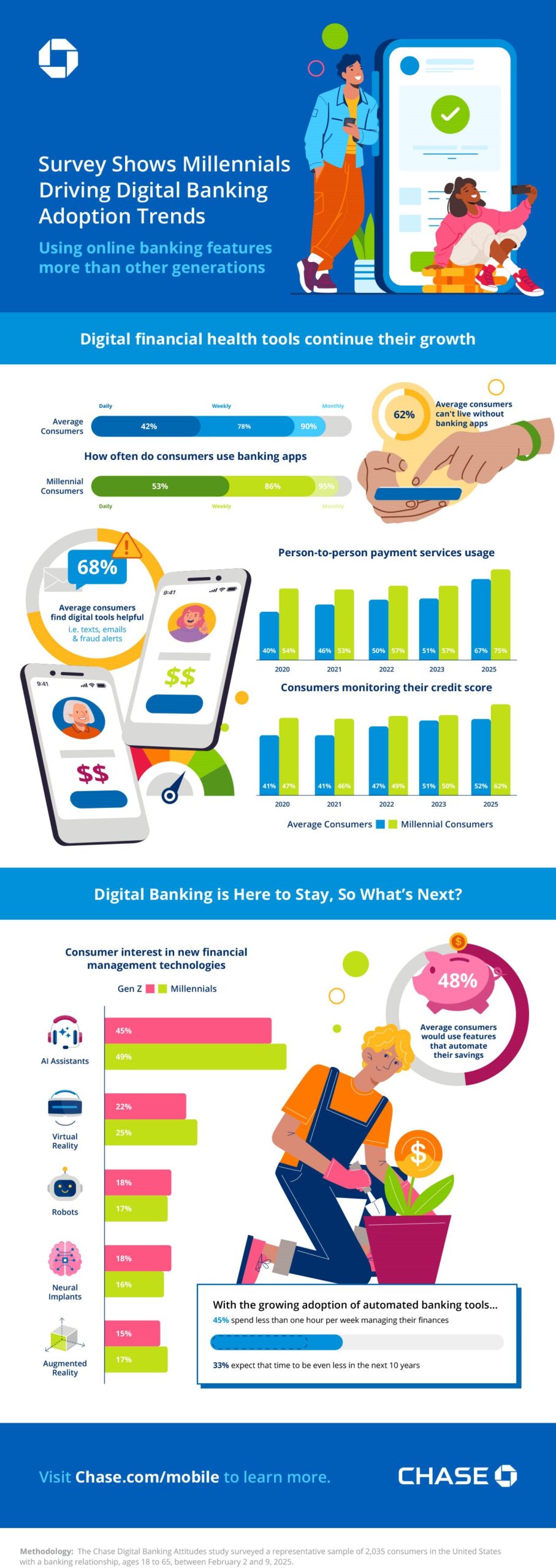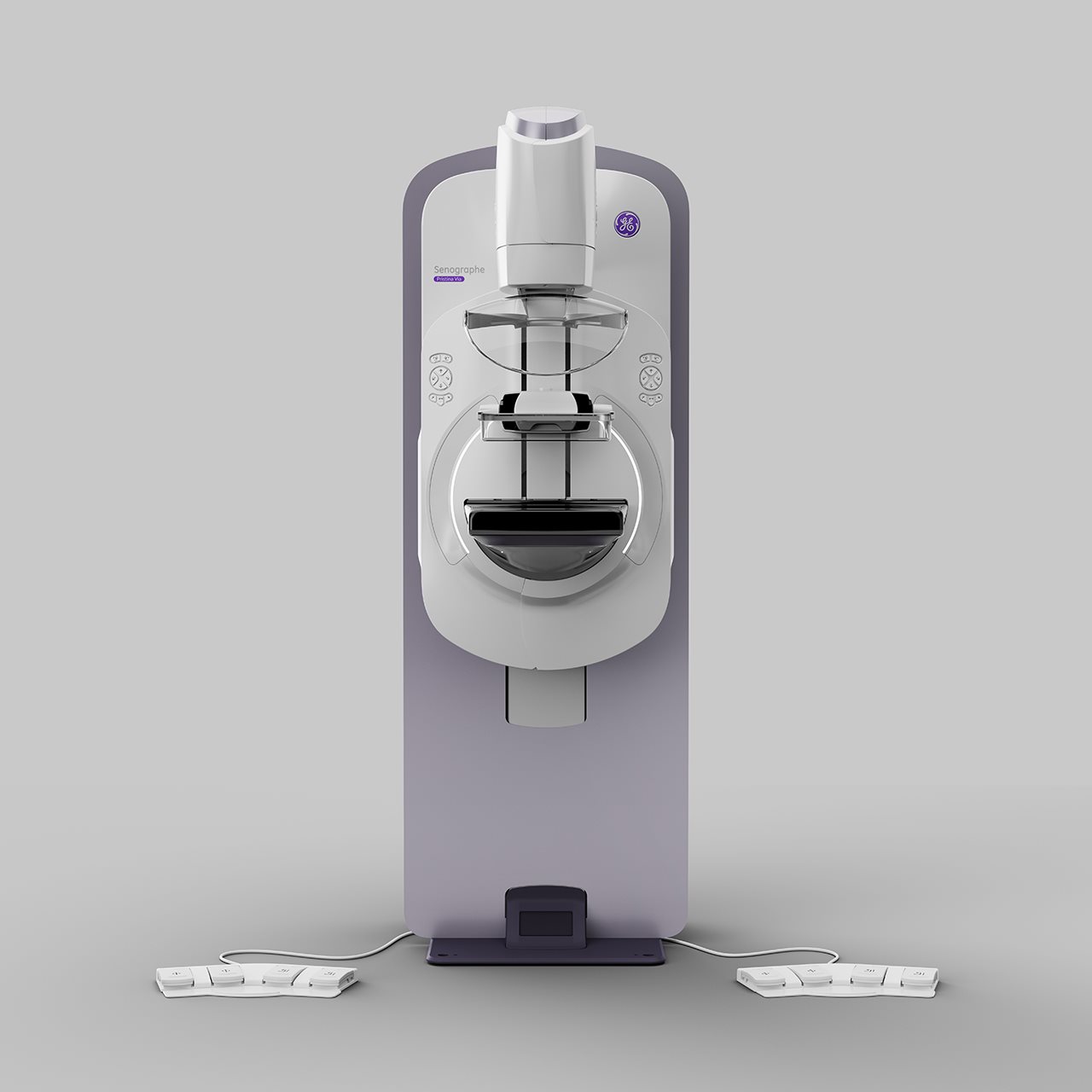2025-07-14T07:01:00
(BPT) – Millennials are using online banking features more than other generations, according to a new survey from Chase. Learn more about their habits below.

2025-07-11T11:19:26
(BPT) – Renting your home? You’re not alone. According to Pew Research, more than 44 million households in the U.S. were rented in 2024 — that’s more than one-third of all homes. And the number keeps growing.
With renting on the rise, it’s never been more important to think about protecting what’s inside your home. That’s where renters insurance comes in. Many people mistakenly believe their landlord’s insurance covers them, but that’s only true for the building — not your belongings.
Mercury Insurance wants renters to know they have options — and that coverage is often more affordable than people think. Renters insurance can help replace your things after theft, fire or other disasters, and even offer liability protection if someone gets hurt in your unit.
“Renters insurance can offer peace of mind when it comes to such things as protection of your personal property and finances,” said Adam Bakonis, Senior Product Manager State for Mercury Insurance. “Some consumers don’t think about renters insurance until they are in a situation in which they need it, so it pays to do some research prior to moving into a rental property so that you are prepared for the unexpected.”
Here are some of the benefits of having renters insurance:
“It’s often said that it’s better to have something and not need it than the other way around — and that’s especially true for renters insurance,” added Bakonis.

2025-07-10T07:01:00
(BPT) – Sponsored by Immunovant
Three years ago, Jesse was living her very best life. An avid hiker, travel enthusiast and professional photographer, she was never short on energy, always up for her next challenge. Then, one morning, she woke up with a swollen face, lips and eyes.
“At first, I shrugged it off as an allergic reaction, but my primary doctor didn’t seem to know what was going on,” said Jesse. “I decided to mention the symptoms to my OB-GYN. She noticed that my thyroid was enlarged and suggested I speak to an endocrinologist.”
What happened next frightened Jesse. She began to rapidly lose weight, experience hair loss, and suffer anxiety and a racing heartbeat. When the endocrinologist finally reviewed her bloodwork, Jesse was not only diagnosed with Graves’ disease, but immediately sent to the emergency room due to her high heart rate and severe symptoms. A few hours later, Jesse was discharged, left to navigate this new, confusing and overwhelming diagnosis.
Understanding Graves’ disease
Graves’ is a common autoimmune disease. In people with autoimmune disease, the body’s immune system mistakenly attacks itself.1,2 Certain autoimmune disorders, like Graves’, are caused by harmful immunoglobulin G (IgG) autoantibodies – they are often unpredictable, and can prove challenging to control.1,3,4 In Graves’ disease, harmful IgG autoantibodies attack the thyroid and cause it to make more hormones than the body needs. The resulting condition is known as hyperthyroidism.1
“Graves’ disease needs to be closely managed, because when it’s left uncontrolled it can lead to serious health complications,” said Mark Lupo, MD, founder and medical director of the Thyroid & Endocrine Center of Florida. “Because the thyroid affects multiple body systems, symptoms that people experience are often very wide-ranging. They can include rapid weight loss, anxiety, tremor, shortness of breath, difficulty concentrating, racing heart, among others.”1,5
People with Graves’ may also show complications of the disease beyond the thyroid. One of the most common is thyroid eye disease where the harmful IgG autoantibodies impact the muscles and tissues around the eyes causing inflammation, pain and bulging eyes.6,7
A challenging condition to manage
For Jesse, the challenges in managing Graves’ disease didn’t end after her hospital visit. She continued to experience significant fluctuations in her thyroid hormone levels – often ranging from exceedingly high to dangerously low. Over the next 1.5 years, Jesse and her endocrinologist worked closely to manage her anti-thyroid medications, but her thyroid levels never seemed to even out.
“I just never felt well. I would go from feeling extreme fatigue to hyper-anxiety. I had constant swelling in my legs, and my eyes were always inflamed,” said Jesse. “The worst part though was that I started pulling away from all the people and things I loved. It was a depressing time.”
According to Dr. Lupo, Jesse’s experience is not an uncommon one. “In my practice, we see about one-third of people who aren’t optimally treated. These people often fluctuate between hypo- and hyperthyroidism, or can’t tolerate medication due to side effects,” said Lupo. “The challenge is that current treatments don’t actually address the underlying autoimmune disease driver – the harmful IgG autoantibodies.”3
Left with few other options, and desperate to feel better, Jesse proceeded with thyroid surgery. While the surgery corrected the symptoms of her hyperthyroidism, she’s now left dealing with lifelong thyroid hormone replacement therapy, chronic low calcium levels and extreme fatigue.
Hope for the future
While Jesse’s life has changed dramatically since her diagnosis, she shares her story to bring awareness and encouragement to others living with Graves’ disease.
“I think it’s important for people with Graves’ to be proactive,” said Jesse. “My advice – reach out to others in the autoimmune disease community, and speak up about your ongoing symptoms. If you aren’t feeling right, it’s important to talk to your doctor about all of your options.”
Today, clinical research is actively advancing to identify treatment options that address the root cause of Graves’ disease. Immunovant, a clinical-stage immunology company, is pursuing a patient-focused development approach with a goal to develop additional treatment options in autoimmune disease, including Graves’ disease. To learn more, visit https://www.immunovant.com/our-science/pipeline-and-therapeutic-areas.
References:

2025-07-10T13:01:00
(BPT) – Tattoos have gone mainstream — about one in three U.S. adults has at least one. Some people consider the pain of getting a tattoo part of the experience or a rite of passage. Others may look for relief via numbing creams, sprays, ice packs or even anesthesia. This is especially true for large tattoos or long sessions, which can last eight hours or more. If you are considering anesthesia for a lengthy tattoo session, make sure the procedure follows the same safety standards as any elective surgery or procedure, according to new guidance from the American Society of Anesthesiologists (ASA). With National Tattoo Day on July 17, it’s the perfect time to remember that safety should be as much of a priority as self-expression.
Leave tattoo anesthesia to anesthesiologists
If you choose anesthesia, you may have several options, including regional anesthesia (which only numbs part of your body), various levels of monitored sedation (from feeling drowsy but aware to not remembering any of the procedure) and general anesthesia (where you are unconscious).
No matter which type of anesthesia you receive, a tattoo artist’s studio is not a medically appropriate setting. Anesthesia comes with risks beyond the tattoo itself. Just as for a colonoscopy, MRI, plastic surgery or any other procedure, anesthesia for tattooing should always be administered by a qualified anesthesia professional, such as an anesthesiologist, and in a facility that is equipped to monitor your safety and handle emergencies. Your anesthesiologist will choose the right facility based on your health and the length of the tattooing session.
“Anesthesia is very safe when delivered by an anesthesiologist, who has the education and training to provide the best care, including determining the most appropriate anesthesia for each patient, monitoring their vital signs during the procedure and managing complications if they arise,” said ASA President Donald E. Arnold, M.D., FACHE, FASA. “Your anesthesiologist will be there for you before, during and after the procedure.”
Tattoo anesthesia 101: What to expect and how to prepare
Before you undergo the procedure, you will meet with your anesthesiologist, who will:
To be sure you are prepared for your anesthesia care you should:
Other considerations are the same as those for elective surgery, including avoiding eating or drinking before the procedure and being prepared to have a urinary catheter if the procedure is long.
Learn more by reviewing ASA’s Patient Guidance on Anesthesia Care for Tattoo Procedures and visiting ASA’s Made for This Moment website to understand the specific types of anesthesia care available, find out more about the critical role anesthesiologists have in keeping you safe and comfortable, and to download ASA’s Anesthesia Care for Tattoo Procedures checklist.

2025-07-09T12:11:00
(BPT) – Have you skipped or delayed your yearly mammogram? You’re not alone. According to a 2023 MedStar Health survey, 59% of American women over 40 skip their annual mammogram, and almost a quarter say they’ve never had one.
There are several reasons why women forgo a mammogram, including myths that the procedure is uncomfortable and painful. However, mammograms are important diagnostic tests that can save lives and offer peace of mind.
Are you avoiding getting a mammogram because of common myths? Check out these five mammogram misconceptions and learn the truth about this critical healthcare procedure.
Myth 1: Mammograms are only necessary if you have a family history of breast cancer
Fact: The American College of Radiology (ACR) breast cancer screening guidelines recommend that women of average risk get an annual mammogram starting at age 40. That means that even if you don’t have a family history of breast cancer, you should schedule a mammogram every year.
Why? Early detection gives you the best chance of treating breast cancer. According to the American Cancer Society (ACS), decades of research show that women who have regular mammograms are more likely to find breast cancer early, are less likely to need aggressive treatments and are more likely to be cured.
Myth 2: Mammograms are painful
Fact: Many women avoid scheduling a mammogram because they think it will be painful. While breast compression isn’t pleasant, the discomfort should only last a few seconds. Talk with your technician. They’re specifically trained to adjust the pressure just enough to get a clear picture.
Myth 3: Mammography technology has not changed
Fact: Mammograms aren’t just manual exams and 2D X-rays. There have been several advances in breast cancer screening. From MRIs to 3D images, the types of screening available show an advancement in the field that helps women get the diagnosis and treatment they need.
For example, GE HealthCare’s Pristina Via™ is one of the latest advancements in mammography systems and is setting a new standard in breast imaging.

Designed to improve patient experience, The Senographe Pristina platform features breast supports with rounded angles, comfortable arm rests and patient-assisted compression, giving women a sense of control during the exam. When asked about their mammogram, 83% of patients reported a more positive experience on the Senographe Pristina Platform compared to previous exams.1
The Pristina Via also eliminates repetitive steps, clicks and wait-time between exposures, which can help minimize the time under compression and prioritizes patient comfort. By streamlining workflow for technicians, you’ll get in and out of the exam quicker.
“Mammograms are an indispensable preventative procedure,” said Jyoti Gupta, Ph.D., president and chief executive officer for Women’s Health and X-ray at GE HealthCare. “That’s why we focus on pushing technology forward to improve not only the experience of healthcare professionals but also to enhance the patient experience. The Pristina Via is designed by women for women with the goal of minimizing the time it takes technologists to perform a mammogram and make mammograms more approachable to those who need it most.”
To learn more about this technology, visit the GE HealthCare website.
Myth 4: Mammograms are time-consuming
Fact: Mammograms aren’t time-intensive. The whole appointment tends to take 20-30 minutes or less, and the actual procedure only lasts a few minutes. Also, new technology like GE HealthCare’s Pristina Via 3D mammogram streamlines the mammogram process so you can get screened faster. Recent analysis found that it can acquire an image in as little as 2 minutes.2
Myth 5: 3D mammograms are the same as traditional ones
Fact: Traditional 2D mammograms compress breast tissue and use low-dose X-rays to capture flat images from above and from the side of each breast. A 3D mammogram, on the other hand, takes several low-dose X-rays (the same as a simple 2D mammogram) in a small arch around your breasts. A computer then combines these images, allowing your doctor to see the breast tissue more clearly in three dimensions, as the name suggests.
3D mammograms increase clinical accuracy, compared to 2D alone, for all types of breasts including dense breasts3, and lower your chance of being called back for a follow-up screening. Another tool for dense breast diagnosis is contrast-enhanced mammography (CEM) which uses an injected dye to examine breast tissue and flag abnormalities with high levels of sensitivity and specificity.
Don’t wait. Now that you know the truth about mammograms, you can confidently schedule an appointment so you can invest in your health and wellness.
Sources
1. Ipsos Patient Satisfaction Study sponsored by GE Healthcare, conducted with 315 patients across 2 sites in Europe, February 2017.
2. Pristina Workflow analysis. Aggregated data from +2k exams and 78 systems worldwide. Data on File. GE Healthcare 2024
3. GE Healthcare’s DBT delivers superior diagnostic accuracy compared to 2D alone for all types of breast densities, including dense breasts. (ref: Superior diagnostic accuracy demonstrated in a reader study comparing the ROC AUC of GE screening protocol (V-Preview + 3D CC/MLO with 3D in STD mode) to that of 2D FFDM alone. FDA PMA P130020)
Disclaimer: Pristina Via is a commercial offering of Senographe Pristina™.

2025-07-08T06:01:00
(BPT) – Health care essentials like over-the-counter (OTC) products can quickly add up and eat into your budget. Whether you’re buying pain medication to manage headaches or antibiotic ointment for cuts and scrapes, stocking your medicine cabinet can be expensive.
Making affordable choices at the pharmacy is especially daunting when trying to manage your environmental impact. Navigating the pharmacy aisle in search of eco-friendly product options during your busy day can feel like an overwhelming task.
If you regularly use OTC medications and want to save more and waste less, you can do so with just a few easy tips. Foster & Thrive, a private-label OTC health and wellness brand, offers five simple ways to make more affordable and sustainable choices when purchasing health care essentials.
1. Use your health insurance plan resources
Do you have a health savings account (HSA) or flexible spending account (FSA)? You can use your funds for more than just copays and medical expenses.
Many pharmacy products, from OTC medication to health and wellness essentials like bandages, are HSA- or FSA-eligible items. Alternatively, your health plan may cover a yearly OTC credit. Check your health insurance plan to see what resources it offers and discover eligible items.
2. Choose private-label items

One of the easiest ways to help save on your OTC expenses is to choose private-label brands. Private-label drugs tend to cost less than brand names while still delivering the same effectiveness.
Foster & Thrive OTC products, for example, provide consumers with reliable care at an affordable price. With over 500 products for acute care, preventive care, everyday care and diagnostic care, you’re likely to find whatever health and wellness OTC products you need.
Private-label goods generally always meet or exceed Food and Drug Administration (FDA) quality, and are tested and compliant with industry-leading quality standards, so you can rest easy knowing you’re using safe and effective products.
3. Chat with your pharmacist

Pharmacists can provide personalized advice to guide your healthcare purchases. Before you select an antacid for a stomachache or acid reflux, check with a pharmacist to ensure you’re choosing the best OTC product for your needs.
A pharmacist can spot potential interactions between an OTC drug and any prescription medications you’re taking. They can also help you pick the right medication and dosage that can help alleviate multiple symptoms so you can avoid buying unnecessary products, saving you money and helping reduce drug waste.
4. Look for sustainable packaging
You can do your part to help the environment by choosing OTC products that come in eco-friendly packaging. Consider buying medications like those from Foster & Thrive’s eco-friendly aluminum product line, which is made with 70% less plastic than traditional bottles. The bottles are designed for recyclability,* and are made primarily of aluminum — one of the most commonly recycled materials in the U.S.1
5. Check out your local, small business pharmacy
There are plenty of chain pharmacies, but if there is a locally owned pharmacy in your area, consider shopping for your OTC products there. Mom-and-pop shops often carry the same private-label and prescription products you can find at larger pharmacies, but with a more personalized focus. Community pharmacists often get to know their patients personally and can deliver more individualized care. They may even offer deals or reward programs that can help defray your health care costs.
OTC expenses don’t have to be expensive. Using these five tips, you can help save on your essential health care expenses so you can focus on investing in your health and wellness. To find a Foster and Thrive retailer near you, visit FosterAndThrive.com/Where-To-Buy.
*Availability of recycling programs and facilities may vary by location.
1. U.S. Environmental Protection Agency. National Overview: Facts and Figures on Materials, Wastes and Recycling.


2025-07-08T09:01:00
(BPT) – A breast cancer diagnosis often brings tough questions: What’s the right treatment for me? How long should I stay on medication? Will the side effects be worth it?
Today, genomic testing is giving women and their providers new tools to make more confident, personalized treatment decisions—especially when it comes to long-term hormone therapy (also called endocrine therapy) for early-stage breast cancer.
Understanding Hormone-Driven Breast Cancer
Many breast cancers are fueled by hormones like estrogen or progesterone. These are called hormone receptor-positive cancers, and they are often treated with endocrine therapy—medications that block or lower hormone levels to help prevent the cancer from coming back. Hormone therapy may be given as a pill, injection, or both.

The standard duration for hormone therapy is five years1, but in some cases, doctors may recommend continuing treatment for up to ten years. This is called extended hormone therapy, and the decision to go beyond five years depends on the individual’s risk of recurrence.
While hormone therapy is effective, it often comes with side effects—such as joint pain, hot flashes, fatigue, and mood changes—that can significantly affect a person’s quality of life. In fact, around 80% of women on hormone therapy report experiencing side effects2, which can lead to missed doses, early discontinuation, or outright refusal to continue or extend treatment. These challenges make it even more important to identify who truly benefits from extended therapy and who may not need it.
By knowing the optimal duration of therapy for each individual, care teams can ensure patients are receiving the benefit of treatment without unnecessary exposure to years of side effects—striking the right balance between reducing recurrence risk and quality of life.
How Genomic Testing Can Help
That’s where genomic tests like MammaPrint® and BluePrint® come in. Together, these tests analyze the activity of specific genes in a breast cancer tumor to reveal how the cancer is likely to behave. This information helps doctors personalize multiple treatment recommendations from the beginning.
With results available within days, these tests provide valuable answers early—sometimes even before surgery—so treatment planning can begin right away.

Personalized Care for the Long Haul
For women with MammaPrint High Risk tumors, studies show that extended hormone therapy beyond five years isn’t necessary, sparing them additional years of side effects.3-4 For others, like those with MammaPrint Low Risk, it can reinforce the importance of staying the course—knowing extended treatment significantly reduces their risk of recurrence.3-4 For women with MammaPrint UltraLow, studies show that tumors may have the option to safely reduce their standard treatment duration based on their exceptionally low recurrence risk.2
Genomic testing doesn’t just guide medication choices—it supports peace of mind. When women understand the “why” behind their treatment plan, they’re more likely to stay with it.
Backed by Research, Built for Everyone
These personalized treatment options are supported by landmark clinical trials—including the Stockholm Tamoxifen Trial (STO-3),2 NSABP B-42,3 and IDEAL4—which show that patients with different MammaPrint risk classifications benefit from different durations of hormone therapy. These studies provide critical evidence that not all patients require extended treatment, and that tailoring therapy duration based on genomic risk can help reduce over-treatment while maintaining strong outcomes. As genomic testing becomes a standard part of care, women and their doctors can work together to create treatment plans that are not just effective—but also personalized, evidence-based, and empowering.
Learn more at Agendia.com.


2025-07-08T03:01:00
(BPT) – If you love spending time in your outdoor space over the summer and autumn months, you probably also look forward to inviting friends and family to hang out with you. But does your backyard area need upgrades to make it more welcoming, functional and relaxing?
Here are easy tips to elevate your space, while also bringing more warmth and a sense of luxury to your backyard.
1. Enhance outdoor get-togethers

Everyone loves to gather around a cozy fire on a summer or autumn evening. To add a heightened level of design and elegance to your gatherings, consider a Kindred Outdoors & Surrounds Fire Bowl. These unique creations have subtle variations in color and texture similar to natural limestone. Made from strong, glass-fiber reinforced concrete, they feature a patent-pending brass burner system that uses half the fuel of conventional fire rings, yet produces higher flames and a brighter appearance. Fire Bowls come complete with lava rock and match-lit components.
Each of the nine different styles of Fire Bowls is available in four color choices that reflect the authentic look of natural limestone. You can opt for either Honed (smooth surface) or Travertine (more textured surface) to complement the look of your overall outdoor space design. To increase functionality, you can also use your Fire Bowl as a beautiful table when fire is not needed with the addition of a Wood Top.
Note: Fire Bowls must be covered from the elements when not in use. The Wood Tops are not designed to be protective covers for the fire bowl when it is not in use.
2. Embrace outdoor cooking
If you’ve always thought that creating an outdoor kitchen was too difficult and time-consuming, think again. With Kindred Signature Kitchens, you’ll get a pre-designed, ready-to-install kitchen setup that allows you to construct the perfect outdoor kitchen in just days instead of weeks. Each kitchen is pre-designed to fit a variety of size and style configurations, and ships complete with all the necessary cabinets, bolts and end-caps.
Kindred Outdoor Signature Kitchens are an easy solution to help you create the timeless look and feel of a stone masonry kitchen. You can finalize your outdoor design by selecting stone or brick finish, appliances and countertop materials of your choice, in these configurations:
3. Design your own custom kitchen structure

Want more flexibility in designing your dream outdoor kitchen? Kindred’s Outdoor Kitchen Cabinets offer a modular solution that lets you build a layout tailored to your cooking and entertaining needs. The outdoor cabinets offer a virtually limitless combination of configurations and can be assembled in just hours. Additionally, cut-outs for custom features such as barbecues, sinks, refrigerators and storage drawers can be done on-site.
Each piece is made of glass-fiber reinforced concrete (GFRC), which can be installed on any solid flooring surface without concrete footings or rebar. They eliminate construction waste and reduce the additional time that’s associated with traditional masonry block installations.

4. Imagine your perfect outdoor space
Need help bringing your dream space to life? The new Kindred Outdoors & Surrounds Outdoor Design Tool offers designers, architects and homeowners an interactive platform that aids in visualizing how Kindred’s products would appear in your outdoor setting. You’ll be able to try out various styles, sizes and colorways to see what works best for your space and your design aesthetic.
Whether you’re starting from scratch or enhancing an existing project, the Kindred Outdoors & Surrounds Design Tool provides helpful images and inspiration to support the creation of your ideal outdoor entertainment space.
To find more resources to help you enhance your backyard, visit MyKindredLiving.com.


2025-07-07T10:01:00
(BPT) – Asthma, allergies and eczema are more common than you may think. More than 28.2 million people in the U.S. have asthma. About one in three adults and one in four children live with allergies. And almost 6% of adults and more than 10% of children have eczema. These conditions can significantly impact daily activities and quality of life.
When symptoms get worse, doctors may prescribe oral corticosteroids (OCS). If you’re prescribed OCS to treat severe flare-ups of these or related conditions, make sure to have an open conversation with your doctor about these medications. Learn how OCS can get symptoms under control. Ask about the risk of potential side effects.
1. What are OCS?
Oral corticosteroids are human-made steroid medications modeled after cortisol, a natural hormone produced by the adrenal glands. These pills or liquid medications are used to quickly reduce inflammation. Examples of OCS include:
OCS are inexpensive, fast-acting drugs. They are typically prescribed in a short course, or burst, of three to five days. That is often all it takes for OCS to provide relief from symptoms.
OCS differ from inhaled corticosteroids (ICS) and topical corticosteroids. ICS, delivered through an inhaler or nebulizer, act directly on the lungs and airways as a daily controller medication for asthma. Topical corticosteroids, on the other hand, are applied to the skin to treat localized inflammation from eczema.
OCS are also different from anabolic steroids, which are related to the male hormone testosterone and sometimes used for muscle building.
2. What are OCS prescribed for?
OCS are powerful anti-inflammatory medications used to treat a wide range of medical conditions. They are mostly prescribed to manage flare-ups of respiratory and allergic conditions, such as asthma, chronic obstructive pulmonary disease (COPD), allergic rhinitis, nasal polyps and sinusitis. They are sometimes used to treat severe flare-ups of skin conditions such as eczema, chronic hives or psoriasis.
In addition, OCS are used to treat autoimmune diseases like arthritis, lupus and inflammatory bowel disease.
3. What are the benefits of OCS?
OCS can quickly reduce inflammation and swelling in various body systems, including the airways and skin. They can provide relief and effectively stop symptoms from worsening.
This is why OCS are prescribed for severe asthma symptoms, nasal inflammation, and eczema flares, among other conditions. They are not usually prescribed for long-term daily management or control of symptoms.
4. What are the potential side effects of short-term OCS use?
OCS can quickly treat flare-ups, but they can cause serious side effects. That’s why doctors prescribe them in short courses of three to five days – to minimize the risk and impact of side effects.
Some short-term side effects include:
5. What are the potential side effects of long-term OCS use?
In rare cases, doctors prescribe OCS for long-term use when inflammation is severe, and the benefits outweigh the risks and side effects.
Long-term use can lead to the following side effects:
6. What is OCS overuse?
Oral corticosteroids have a high rate of success in treating flare-ups. As a result, some people may develop a reliance on them for treatment. They may want to continue taking OCS to keep their condition under control.
OCS overuse is defined as when you take the medication at a dose or duration that increases the risk of adverse effects without a clear benefit.
The overuse may occur when you:
How much is too much? This is a conversation you should have with your doctor to decide what’s best for your medical condition.
7. How to prevent OCS overuse?
If you are prescribed two or more courses of oral corticosteroids per year, this is a sign that your condition is not well-controlled. You may need to adjust your treatment plan instead of continuing to rely on OCS.
Talk with your doctor – preferably a specialist such as an allergist or dermatologist – to discuss treatment options. Ask about advanced treatments such as biologics to help keep your symptoms in check.
Learn more about OCS and OCS overuse at AllergyAsthmaNetwork.org.

2025-07-07T11:01:00
(BPT) – Given the option, people like to buy from a real person. There’s pride in keeping small businesses open and more dollars in the local community. These businesses make up 99% of U.S. companies and account for 45% of jobs. They sponsor the neighborhood Little League and know their customers by name and face when they see each other in town.
So why aren’t small businesses winning more often?
Big companies have big budgets, teams and tools. They put themselves at the top of Google searches and have call centers to capture customer interest. What they lack in customer service, they make up with availability. After all, small businesses that can’t be available to answer the phone at all times can’t offer the personalized service that sets them apart. How can a small business compete without having to work 24/7 or hire more people than they can afford? The answer to getting more manpower, while maybe counterintuitive, is artificial intelligence (AI).
McKinsey reported that 90% of Fortune 500 companies are incorporating AI. Meanwhile, just over half of small businesses take advantage of the new technology, according to American Express’ Trendex report. Corporations can afford to test multiple softwares or hire more people to support the technology. They also likely have a better cost-to-benefit ratio than small businesses. Furthermore, most enterprise AI is too complicated, too expensive or too impersonal for local shops.
That is where solutions like OpenPhone enter — AI specifically built for growing businesses. In this case, to ensure no call or customer is ignored while allowing local mom-and-pops to keep the high-touch, personal services they’re known and loved for. Even bigger operations, like a franchise, can enlist this kind of AI across locations to help maintain customer service standards without the complication and cost that often come with solutions meant for corporations. Businesses can go from 30% of their callers leaving a message to 90% engaging with the company overnight.
“It’s all about making it easy for the customer,” Pink’s Windows’ Brandon Downer and Carter Smith said about their decision to adopt the system. When messages come in after hours or while all hands are on the job, the AI responds to gather essential information and kick off Pink’s Windows’ same-day quote promise. AI-generated call summaries then ensure the team can quickly provide quality service. It also helps meet younger customers where they want — via text — without having to stay attached to the phone.
ChatGPT and viral photo editing filters are glimpses into the power of AI at a large scale. When small businesses evaluate AI tools to help them compete with big business, consider the following:
Technology has helped make running a small business easier in many ways. Not long ago, a good website was only possible for bigger companies with developers and designers. Bulky cash registers were standard until Square and tap-to-pay revolutionized point of sale.
AI is here to stay. Don’t be intimidated by the novelty or its transformative nature. Turning thoughtfully to AI can give human teams time back for the parts of the business they — and their customers — love.
